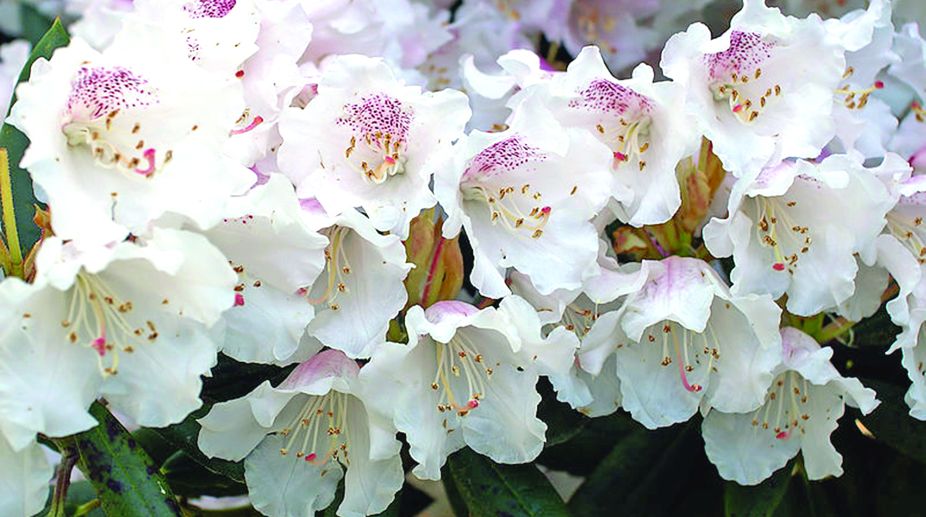Spring is the beloved’s messenger; the rose its representation. Warm breezes revive the garden with fragrance which, like wine, intoxicates the trees and flowers that sway with joy. The tulip brings good tidings; the lily with its multiple tongues reveals secrets, the blue-robed violet bows its head in prayer. Methods of personification give everything a function and an attribute. The tulip is branded by love. The narcissus is all eyes. The lily all tongue. Water is the life-giving force.
The symbol of the world garden is the rose; emblem of all that is beautiful, transient and fading. The nightingale’s lament arises from the notion that the rose’s smile foreshadows its scattering.
Advertisement
My focus is Mirza Asadullah Khan Ghalib’s poetry garden. Ghalib produced remarkable poetry in two languages that, despite sharing many aspects of the ghazal tradition, drew on culturally specific themes. Access to a variety of themes gave Ghalib’s poetry an unusual edginess. For example, while Ghalib’s garden mirrors Persian tropes, he complicates the familiar images with far-fetched metaphors. He had a penchant for playing with perceptions of reality. As seen from his early poetry, Ghalib projects the garden as a mysterious place, almost illusory, even frightening and forbidding without the beloved,
Baagh tujh bin gul-i-nargis se daraata hai mujhe Chaahoon gar sair-i-chaman aankh dikhaata hai mujhe (In your absence, the garden frightens me with the narcissus/ If I want to take a stroll, it glares at me) I was tempted to translate the verse as, “The narcissus scares me in your absence/ It glares at me if I venture for a stroll.” But Ghalib is saying that the garden intimidates, using the narcissus’s eyes to scare. Clearly, the key point here is tujh bin (without you).
The garden belongs to the beloved. But there is a fine puzzle here. Why does the garden want to intimidate the lover? Why are the narcissus’s beautiful eyes fear-invoking? An answer could be that the crazed lover is hallucinating. Separation makes the lover fearful and the fear is projected on the garden. However we choose to read this verse, one cannot escape the wildly fantastic image of the garden, usually a paradise, now transformed into an enchanted space where flowers stare forbiddingly.
But Ghalib wasn’t happy with this opening verse and replaced it with a less obscure, more frightening one,
Baagh paa ker khafqaani yeh daraata hai mujhe
Saya-i-shaakh-i-gul afaee nazar aata hai mujhe
(Sensing my unreasonable fears, the garden frightens me/ A flowering branch’s shadow looks a snake to me)
So, it appears that the lover-protagonist is prone to unreasonable fears; his heart palpitates in high rhythm at the slightest provocation. The lover goes out to the garden, but is so anxious in his state of separation that a flowering branch looks like a snake. Ghalib cleverly alludes to the snake in the garden of Paradise to add another layer of meaning.
The lover goes to the garden alone, therefore he is guilt-ridden; the garden, the beloved’s home, sensing this fear plays on it. The imagery is once again fantasy filled. The lover is now in the garden but plagued with snakes and other fear-invoking thoughts.
Ghalib’s contemporary, Imam Bakhsh Nasikh, has an excellent verse — more striking and picturesque — on a similar theme,
Kya shab-i-mahtaab main be yar jaoon bagh ko
Sare patton ko bana deti hai khanjar chandni
(Going to the garden on a moonlit night without my lover?/ Moonbeams make leaves into daggers); or, (How can I go to the garden on moonlit nights without my lover?/ All leaves become daggers in the moonlight)
Nasikh talks about two extremely romantic things for a lover — moonlit nights and gardens — and beautifully plays on visual tricks that moonlight produces. Presumably the trees are mango or Asoka, with long pointy leaves that glint like daggers in the moonlight. Love and daggers go together in the ghazal world. The pain of separation is like a dagger in the heart. In a moonlit garden, separation’s pain is intensified to the point that all leaves are like daggers.
Nasikh’s imagery is silvery, not dark or disturbing, even though he talks of daggers, because we are familiar with the trope. Ghalib’s imagery is tense and disquieting. Both poets approach the garden as a meeting place for lovers, but the symbolism they use is quite different.
For an example that illustrates the multivalences of the garden in Urdu poetry, Main chaman mein kya gaya goya daabistan khul gaya Bulbulen sun kar mere nale ghazal khwan ho gayen (I had barely entered the garden — when a school opened, so to speak/ Bulbuls hearing my laments began reciting ghazals) The bulbul is known for its lilting song that tells a thousand stories of love. The bird symbolises eternal love for the rose, and its song is unparalleled. Now, Ghalib the poet has surpassed the bulbul’s song. He is the master of poetry’s garden. No sooner does the master poet enter the garden or poetic gathering, the bulbuls break into song.
Their song can be interpreted in several ways. First, that they acknowledge the poet’s stature as a master and sing their own song by way of repetition, creating a classroom-like atmosphere.
The verse’s second line adds another dimension. The poet’s lament-song was so effective and melodious that bulbuls, known for their soul-stirring song, became ghazal reciters. The key to this verse lies in the subtle link between birdsong and ghazal.
The verse demonstrates the understated slippage between the garden as a place for lovers and the garden as space for poetry. The song is metrically perfect; so is the ghazal. The pain of love is common to both. The perfect lament is ecstasy.
The columnist is an associate professor in the Department of Middle Eastern and South Asian Languages and Cultures at the University of Virginia, US
Dawn/ann











